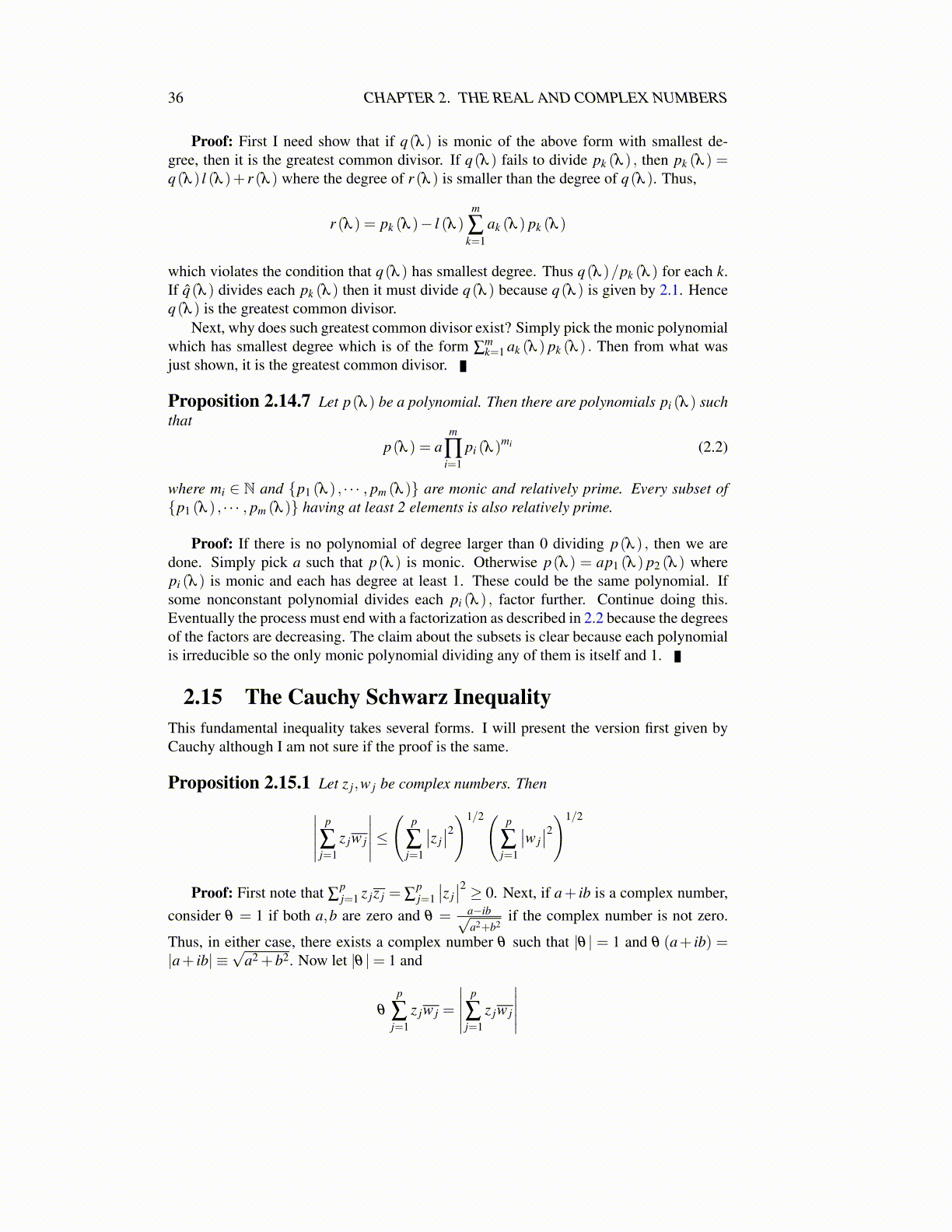
36 CHAPTER 2. THE REAL AND COMPLEX NUMBERS
Proof: If there is no polynomial of degree larger than 0 dividing p(λ ) , then we aredone. Simply pick a such that p(λ ) is monic. Otherwise p(λ ) = ap1 (λ ) p2 (λ ) wherepi (λ ) is monic and each has degree at least 1. These could be the same polynomial. Ifsome nonconstant polynomial divides each pi (λ ) , factor further. Continue doing this.Eventually the process must end with a factorization as described in 2.2 because the degreesof the factors are decreasing. The claim about the subsets is clear because each polynomialis irreducible so the only monic polynomial dividing any of them is itself and 1.
2.15 The Cauchy Schwarz InequalityThis fundamental inequality takes several forms. I will present the version first given byCauchy although I am not sure if the proof is the same.
Proposition 2.15.1 Let z j,w j be complex numbers. Then∣∣∣∣∣ p
∑j=1
z jw j
∣∣∣∣∣≤(
p
∑j=1
∣∣z j∣∣2)1/2( p
∑j=1
∣∣w j∣∣2)1/2
Proof: First note that ∑pj=1 z jz j = ∑
pj=1
∣∣z j∣∣2 ≥ 0. Next, if a+ ib is a complex number,
consider θ = 1 if both a,b are zero and θ = a−ib√a2+b2
if the complex number is not zero.
Thus, in either case, there exists a complex number θ such that |θ | = 1 and θ (a+ ib) =
|a+ ib| ≡√
a2 +b2. Now let |θ | = 1 and θ ∑pj=1 z jw j =
∣∣∣∑pj=1 z jw j
∣∣∣ Then for t a realnumber,
0≤ p(t)≡p
∑j=1
(z j + tθw j)(z j + tθw j
)=
a2︷ ︸︸ ︷p
∑j=1
z jz j +p
∑j=1
z jtθw j +p
∑j=1
tθw jz j + t2
b2︷ ︸︸ ︷p
∑j=1
w jw j
≡ a2 +2t Reθ
p
∑j=1
w jz j + t2b2 = a2 +2t
∣∣∣∣∣ p
∑j=1
w jz j
∣∣∣∣∣+ t2b2
Since this is always nonnegative for all real t, it follows from the quadratic formula that
4
∣∣∣∣∣ p
∑j=1
w jz j
∣∣∣∣∣2
−4a2b2 = 4
∣∣∣∣∣ p
∑j=1
w jz j
∣∣∣∣∣2
−4
(p
∑j=1
z jz j
)(p
∑j=1
w jw j
)≤ 0
Indeed, p(t)= 0 either has exactly one real root or no real roots. Thus the desired inequalityfollows.
2.16 Integer Multiples of Irrational NumbersThis section will give a proof of a remarkable result. I think its proof, based on the pigeonhole principle, is even more interesting than the result obtained. Dirichlet proved it inthe 1830’s. Jacobi used similar ideas around the same time in studying elliptic functions.The theorem involves the sum of integer multiples of numbers whose ratio is irrational.If a/b is irrational, then it is not possible that ma+ nb = 0,m,m ∈ Z because if this were